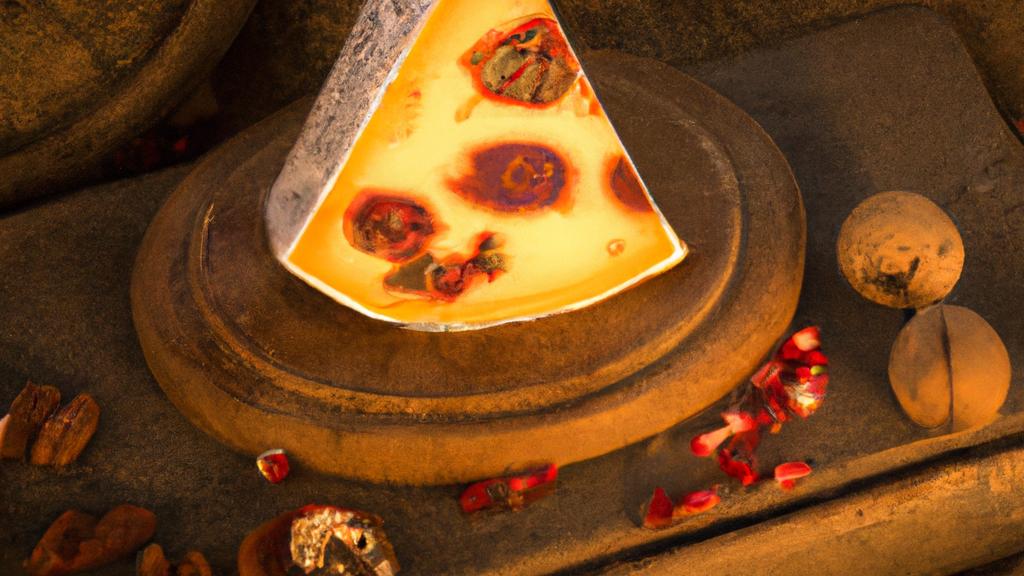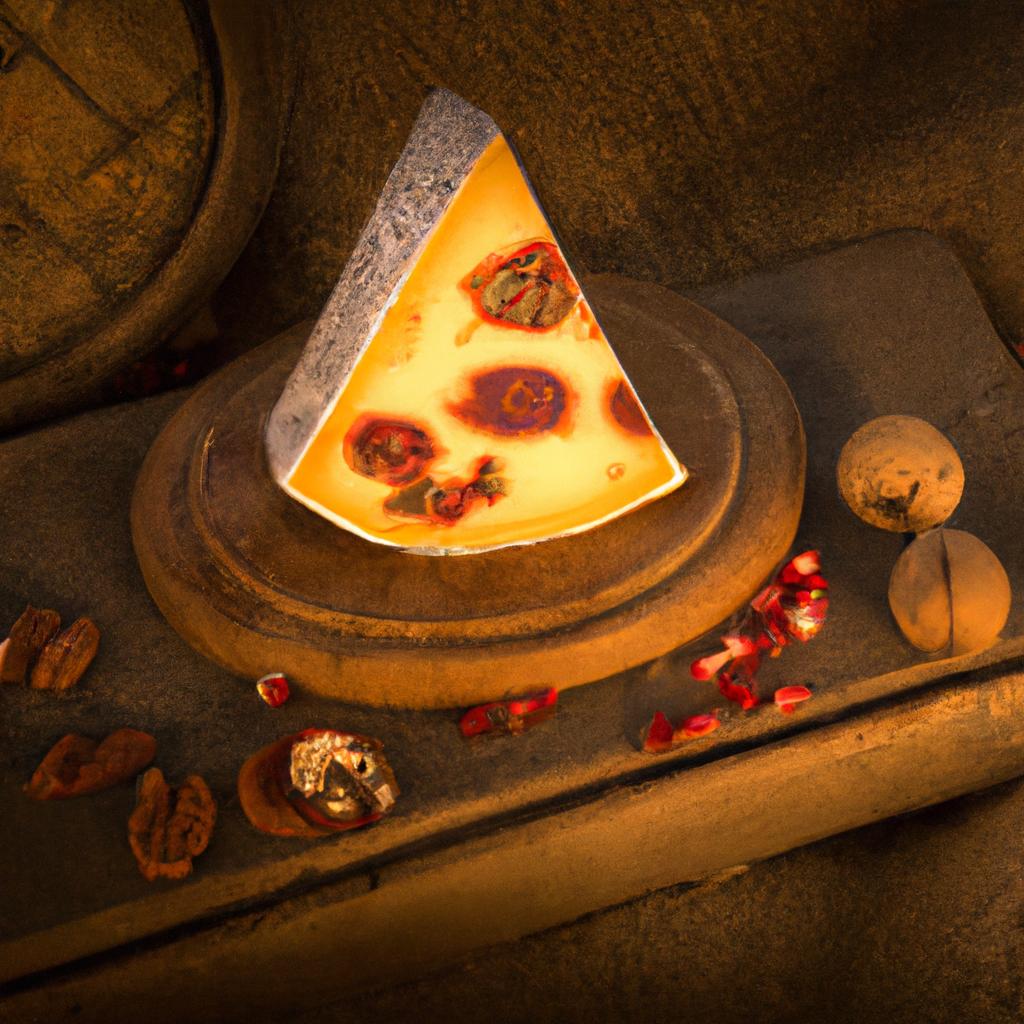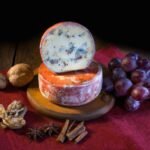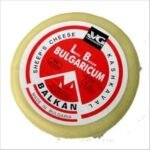
Set amidst the verdant plains of Eastern Europe, Orbelus cheese stands as an epitome of culinary artistry and rich cultural heritage. Delicately crafted by the skilled artisans in the region, Orbelus cheese is much more than a dairy product; it is the result of time-honored traditions passed down through generations. Made from the milk of grass-fed cows and buffalos, this cheese is noted for its exceptional quality and unique flavors that create a sensory delight for every gourmand.
Orbelus cheese features a semi-hard to hard texture, replete with small to medium-sized eyes. It usually assumes a pale yellow color on the exterior, which gradually deepens towards the core. The cheese boasts a smooth and waxy touch that perfectly complements the subtly sweet and full-rounded taste. However, it’s the nutty undertone that makes Orbelus stand out in a cheese litany. This cheese is indeed a compilation of multifaceted flavors, delicately balanced to offer a singular taste sensation that is seldom found among its counterparts.
Produced primarily in the locally-owned dairy farms, Orbelus cheese is a testament to the region’s dairy-crafting heritage and the passion of its craftsmen. Each stage of production, from milk selection, setting, cutting, cooking, to maturing, is handled with meticulous precision. These stages dictate the cheese’s firm texture, color, taste, and, most importantly, its signature aroma, commonly described as a fragrant medley of fresh milk, melted butter, and a light briny note. Noteworthy, the Orbelus cheese culinary portfolio includes:
- Orbelus in Sauced Pasta: Melted and integrated into a creamy-based sauce, Orbelus brings a contrasting tangy kick to pasta dishes.
- Orbelus-filled Gourmet Sandwiches: Thinly sliced, the cheese enhances the overall flavor profile with its smooth yet crisp texture.
- Orbelus paired with Wine: It is best enjoyed with a glass of full-bodied red wine, which complements its intense flavors.
As a result, Orbelus cheese offers a unique gastronomic experience that reveals itself in multiple layers to each connoisseur. With every bite, one uncovers an aspect of the region’s gastronomic landscape, history, and craftsmanship, making it more than just a cheese, but a savory journey through Eastern Europe’s rich dairy culture.
Welcome to our quiz about Orbelus, a traditonal Bulgarian cheese! How well do you know the cheese? Are you ready to unravel the art of cheesemaking and dive into Bulgarian food culture? Start now!
A Deeper Exploration of Orbelus Cheese: Ingredients, Properties, and Varieties
Renowned in the world of cheese connoisseurs, Orbelus is a hidden gem that never fails to leave a memorable impression on the palate. As an artisan, Bulgarian-made cheese, it shares commonality with its fellow Balkan counterpoints, but distinguishes itself through its unique flavor profile and meticulous production process.
Orbelus cheese derives its distinct taste and texture from the quality and composition of its ingredients: locally sourced milk, live bacterial cultures, and rennet. The purity and freshness of these elements are of paramount importance, as they directly impact the eventual flavor and texture of the cheese. The milk used in Orbelus cheese production is typically cow’s milk, boasting a high fat content that lends the cheese its unctuous and creamy properties.
The production process of Orbelus cheese further heightens its character. After pasteurization, the milk is cultured with bacterial strains, followed by the addition of rennet to initiate coagulation. These curds are then fermented, cut into small pieces, and placed in brine. The fermentation process contributes to the cheese’s slightly tangy flavor, while brining imbues it with its characteristic saltiness. It’s worth noting that the aging process – typically, a period of several weeks – further intensifies these flavors and enhances the cheese’s bite and complexity.
Orbelus cheese comes in numerous varieties, differentiated by taste, texture, and aging time:
- Semi-hard Orbelus: After a moderate aging period, this variety yields a semi-hard texture and subtly tangy flavor.
- Orbelus “Stara Planina”: Named after the Balkan mountain range, this variety is characterized by its robust flavor, derived from an extended aging period.
- Orbelus “Rodopi”: In homage to the lush Rhodope Mountains, this cheese offers a delicious balance of creaminess and zest, achieved by its unique combination of cow’s and goat’s milk.
The remarkable taste profile, careful craftsmanship, and diverse varieties of Orbelus cheese make it one of the most beloved, yet underappreciated, cheeses from the Balkan region. Its characteristics offer an exciting endeavor into the realm of cheese tasting for food lovers around the globe.
Exploring the Unique Flavors of Orbelus Cheese: A Delight from the Rhodope Mountains
Venture into the enchanting Rhodope Mountains of Bulgaria, and you will uncover the hidden gem known as Orbelus Cheese. This exquisite artisanal cheese is crafted in the rich agricultural lands surrounding the villages of Kapatovo and Plevnik. Here, in this picturesque region, a group of passionate cheese artisans at the Orbelus dairy farm are dedicated to preserving the centuries-old craft of cheese-making.
The Rhodope Mountains, located in southern Bulgaria, boast a diverse and stunning landscape filled with lush meadows, verdant forests, and crystal-clear springs. This breathtaking setting is key to the unique flavors of Orbelus Cheese, as the quality of the milk is directly influenced by the abundant and diverse vegetation that the local cows graze upon. The alpine herbs, wildflowers, and aromatic grasses create a distinctive terroir that is imparted in every bite of Orbelus Cheese.
Orbelus Cheese takes its name from the ancient Thracian deity, Orbelus, who was believed to be the protector of the Rhodope Mountains. Just like its namesake, this cheese embodies the spirit of the region and showcases the deep connection between the land, the dairy farmers, and the final product. With its rich history and commitment to artisanal craftsmanship, Orbelus Cheese has gained recognition both locally and internationally as a true culinary treasure.
- The Rhodope Mountains of Bulgaria provide a breathtaking landscape for the production of Orbelus Cheese.
- The diverse vegetation, including alpine herbs and wildflowers, lends unique flavors to the cheese.
- Orbelus Cheese derives its name from the ancient Thracian deity, Orbelus, symbolizing the connection between the land and the product.
- This artisanal cheese has gained acclaim both domestically and globally for its exceptional quality and craftsmanship.
- With over 400 varieties of cheese, Bulgaria is indeed a heaven for cheese lovers.
- Orbelus, among other Bulgarian cheese, contributes to the country’s annual dairy production.
- Bulgaria is known for its rich pastures and mountains – the perfect setting for cheese making.
- Cheese, including Orbelus, is a staple in Bulgarian cuisine.
- Traditionally, Bulgarians consume high quantities of cheese.
- Bulgarian cheese like Orbelus is making its mark in the international cheese market.
- The cheese production business contributes to the economy of Bulgaria.
Exploring the Culinary Potential of Orbelus Cheese: A Pair of Extraordinary Recipes
Originating in the heart of Bulgaria, Orbelus Cheese, a high-quality dairy product, has been prized for its distinct nutty flavor, creamy yet firm texture, and delicate cheesy aroma. Creatively integrating this exquisite cheese into recipes can offer an intriguing blend of taste and texture that sets any meal apart. Here, we explore two exceptional recipes that have Orbelus Cheese as their star ingredient: “Orbelus Cheese Stuffed Bell Peppers” and “Creamy Orbelus Cheese Risotto.”
Orbelus Cheese Stuffed Bell Peppers offer a harmonious melody of flavors and vibrant colors that charm the palette and the eye alike. The recipe is fairly simple:
- Choose four large bell peppers of various colors for an eye-catching presentation.
- For the stuffing, mix one cup of cooked quinoa with half a cup of finely chopped fresh parsley, a half cup of diced tomatoes, and copious amounts of crumbled Orbelus Cheese.
- Indent the top of each pepper and remove the seeds, then stuff them with the quinoa mix.
- Place them in a baking dish with a bit of water on the bottom and bake at 180°C (356°F) for about 25 minutes or until the peppers are soft and the cheese has melted and formed a deliciously crispy top layer.
For something heartier, the Creamy Orbelus Cheese Risotto is a pure comfort food. The creamy, melt-in-your-mouth texture of the Orbelus cheese perfectly complements the al dente risotto grains, creating a culinary symphony. Start by sautéing finely chopped onions in olive oil until translucent. Add Arborio rice and cook until the grains become slightly translucent before adding a splash of quality white wine. Once the wine is absorbed, begin adding hot vegetable broth, ladle by ladle, stirring regularly. Once the risotto is al dente, stir in generous amounts of grated Orbelus Cheese until the risotto becomes creamy and the cheese is thoroughly melted. Sprinkle with freshly ground black pepper and garnish with fresh parsley before serving.
While these recipes vary in their complexity, both offer delightful culinary experiences adroitly showcasing the versatility of Orbelus Cheese. They remind us again why this delicious Bulgarian cheese holds such an exalted position in the pantheon of international cheeses.
Exquisite Matches: Wines And Dishes For Orbelus Cheese
Derived from the verdant heartlands of France, Orbelus, a complex and intriguing cheese, offers a rich combination of sweet, nutty, and buttery undertones aplenty, encapsulating a world of flavors within its creamy core. However, as with any cheese of its caliber, its gastronomic experience is often only fully expressed against the contrasting and complementary dynamics of certain wines and dishes. While Orbelus is undeniably an indulgence in itself, its harmony with select culinary components can elevate the overall tasting journey to an unmatched level of gourmet pleasure.
The luscious texture and robust profile of Orbelus cheese necessitate a wine that can stand up to its strength while simultaneously highlighting its unique characteristics. Thus, a full-bodied red wine like a French Cabernet Sauvignon can be a perfect match. Its tannin structure and potent berry essence underscore the cheese’s creamy dimension while respecting its nutty underpinning. A noteworthy alternative would be a medium-bodied white wine like a Chardonnay. Known for its buttery nuances and apple-crisp freshness, a well-balanced Chardonnay can echo Orbelus’ elegant creaminess while refreshing the palate. As for sweeter pairings, a Sauternes, with its luscious golden-hued charm and honeyed depth, accentuates the sweet, caramel hint innate in Orbelus, creating an intense sensory rendezvous.
When it comes to pairing with food, Orbelus offers an exciting palette of opportunities. Some select dishes guaranteed to escalate the culinary experience with Orbelus Cheese include:
- Roasted mushrooms: The earthiness of the mushrooms complements the sweet, nutty notes of Orbelus, creating a harmonious culinary pairing.
- Grilled meat: The rich flavors and textures of meats like steak or lamb can stand up to the intensity of Orbelus, with the cheese’s creaminess adding a sublime touch to the meat-packed course.
- Fruit and nuts: Fresh fruits such as pears or apples, dried fruits like apricots or figs, and assorted nuts serve as a contrasting yet delightful accompaniment, amplifying Orbelus’ inherent sweetness and nuttiness.
Be it a celebration, a quiet evening, or a gastronomic exploration, Orbelus presents an intriguing world of taste. With the right combinations, one’s journey into this compelling cheese’s depth can turn into an unforgettable adventure of flavors.
Similar Cheeses to Orbelus Cheese
If you’re a cheese lover and have tried and enjoyed Orbelus Cheese, then you may be interested in exploring other cheeses that offer a similar taste and experience. While Orbelus Cheese has its unique characteristics, there are a few other cheeses that share some similarities in flavor, texture, and aroma. Here are a few options to consider:
1. Brie de Meaux:
Brie de Meaux is a French cheese made from cow’s milk and is known for its creamy texture and rich flavor. It has a bloomy rind, a soft, gooey interior, and a complex taste that can range from earthy and mushroom-like to slightly nutty. Similar to Orbelus Cheese, Brie de Meaux pairs well with fruits, bread, and light-bodied wines.
2. Manchego:
Manchego is a Spanish cheese made from sheep’s milk and has a firm, slightly grainy texture. It has a nutty and buttery flavor that can be mild or more robust, depending on its aging. Manchego is often enjoyed on its own or paired with cured meats, olives, and Spanish red wines. The distinct flavors and textures of Manchego make it a suitable alternative to Orbelus Cheese.
3. Gorgonzola Dolce:
Gorgonzola Dolce is an Italian blue cheese made from cow’s milk. It has a creamy and soft texture with a distinctive blue veining throughout. The cheese has a delicate and sweet flavor that is less pungent compared to other blue cheeses. Gorgonzola Dolce is often enjoyed as a dessert cheese or crumbled over salads. Its unique characteristics make it a potential substitute for Orbelus Cheese.
- Consider trying Brie de Meaux, a French cheese known for its creamy texture and rich flavor.
- Manchego, a Spanish cheese made from sheep’s milk, offers a firm texture and a nutty taste.
- Gorgonzola Dolce, an Italian blue cheese, has a creamy texture and a mild, sweet flavor.



